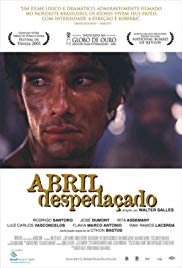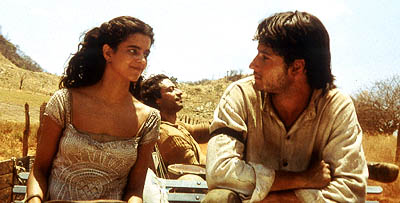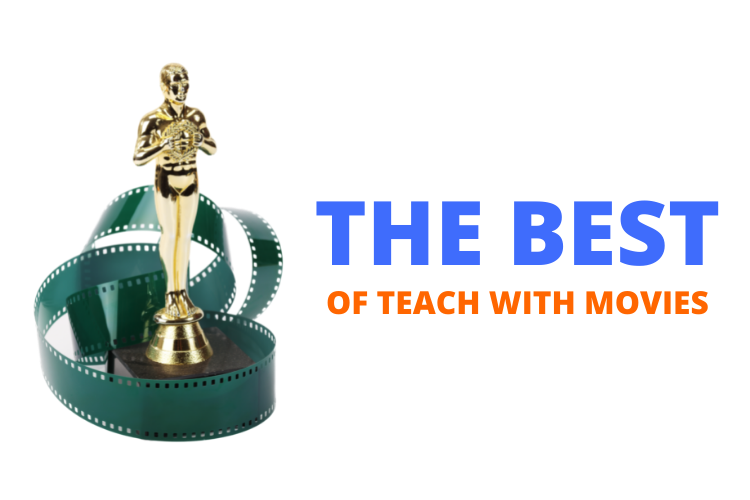COMPREHENSION TEST/HOMEWORK ASSIGNMENT
This test/assignment consists of 17 questions with twenty points. The test/assignment is suitable for grades 8 – 12. The quality of the answers required of the higher grades should be more rigorous than those required of the lower grades. Question #1 counts for two points and question #3 counts for three points. The information covered in this test is contained in the Helpful Background section of the Learning Guide. For lecture notes that summarize the information covered in this test, click here. For a version of this test/assignment suitable to be passed out to students, see Behind the Sun — Comprehension Test/Homework Assignment. This webpage serves as the answer key for the test/assignment.
1. Describe two important themes of this movie. Use less than three sentences to describe each theme. (two points)
Suggested Response:
[Any statement referring to the basic issues outlined below should qualify as identifying one of the themes.]
A. Acts of vengeance, especially cycles of revenge, not only lead to unnecessary death and injury, they are destructive to the fabric of society, family relationships, and morality.
B. Parents betray their obligations to nurture their children when in the service of revenge, of an ideology, or of a desire for standing in the community, they put their children at risk.
C. It often takes an act of transcendent courage and self-sacrifice to stop a cycle of violence.
D. Often, only a person as innocent as a child has the moral insight and courage necessary to take the first steps to stop a cycle of violence.
E. Blind acceptance of tradition can lead to unnecessary suffering.
F. The end of isolation and the knowledge that another life is possible can lead people to break out of the pathologies of abusive families and isolated dysfunctional communities.
G. To find themselves and live their own lives, children may have to break out of the restrictions of their families. Examples in this film are the stories of the Kid, Tonio, and Clara. This is especially true when the parents are abusive and do not nurture their children.
H. Religion is misused when it endorses actions which are against the basic beliefs of the religion.
I. Revenge is against the teachings of Christianity.
2. Give an example of a flashback from this movie.
Suggested Response:
There are two. An answer with a description of one of them should get full credit. Almost the entire movie is a flashback. The movie opens with the Kid walking down a road, wearing Tonio’s black armband and Tonio’s floppy hat. This is just before he is killed. He tells his story, which comprises the bulk of the film. The Kid’s story starts before Tonio kills the man from the Ferreira family. Then within the larger flashback, the Kid has a dream about the time when his brother Ignacio was killed. This also serves as a flashback.
3. There are many literary/cinematic symbols in this film. List six of them and describe what they represent. (Each symbol counts for 1/2 of a point; total three points)
Suggested Response:
Here are several:
1. The oxen going round and round, especially when they continue on their own, symbolizes the condition of the Breves family: stuck in a rut of grinding poverty and endless violence in which they are doing the same things that got them nowhere in the past. The oxen and their endless trek without progress also symbolize the plight of anyone who adheres to an outdated, dysfunctional tradition, such as an honor culture.
2. The dead tree in the yard of the Breves homestead symbolizes the dead emotional life of the Breves family with its lack of parental love and its failure to nurture.
3. Swinging (at the Breves home and at the circus) symbolizes a release from the restricted and unsatisfying existence endured by the young people shown in the film.
4. The book with the mermaid story symbolizes the promise of a better world outside the limits of the Breves family with its impoverished emotional life and its dead-end feud.
5. The Kid’s inability to read is a symbol of the restrictions placed by his parents on his ability to lead a satisfying life —on his future.
6. The fact that the Kid understands the message of the book without being able to read is a symbol of the Kid’s intuitive ability to understand the truth despite the limitations of his environment.
7. Blindness and the inability to see are a symbol for the failure to see the right way to live. See Motif below.
8. The fork in the road represents a choice between the two alternatives open to Tonio: the village/restrictive tradition/death vs. the seashore and freedom from the death that awaits him in the honor culture.
9. The terrible dryness of the land symbolizes the barrenness of the honor culture and the limited life that it imposes on its adherents.
10. The harsh sunlight symbolizes the aridness of the emotional environment of the honor culture.
11. The rain symbolizes the love that releases Tonio from the sterile environment and the lack of nurturing of the Breves family.
12. The black armband shows that a person is marked for death. The action of taking off Tonio’s black armband symbolizes rejection of the constraints of the honor culture. When the Kid puts on Tonio’s armband he is taking Tonio’s place in the vendetta and freeing Tonio from any honor culture obligations.
13. The fact that “the Kid” is not given a name by his parents symbolizes that they had given up believing that this child would live long enough to be a real person.
14. The fact that the Kid was given a name by the man who ran the itinerant circus is a symbol of how people free of the honor culture can provide the caring and information needed to escape a dead-end life.
15. The seashore symbolizes a life free of the constraints of the honor culture.
4. The Kid loves it when Tonio pushes him in the swing that hangs from the dead tree in yard of the Breves family. After Tonio returns from the circus, the Kid insists on taking Tonio’s place as the person who pushes and that Tonio take his place as the person who is swinging. This is an example of the literary device called “foreshadowing.” What event does this scene foreshadow?
Suggested Response:
It foreshadows the Kid taking Tonio’s place in the vendetta and Tonio’s escape from the cycle of retribution.
5. Tonio’s black armband is a sign that means something to the characters in the story as well as a literary/cinematic symbol for the viewer. One of the characters does something to the armband and that action is both a signal to the characters in the movie of a change in Tonio’s status and also a literary/cinematic symbol. Answer both of the following questions: (1) What does the black armband mean to the characters in the story? and (2) What is the significance of what happened to the armband both to the characters in the story and as a literary/cinematic symbol?
Suggested Response:
(1) The armband as a symbol of someone who is bound up in the honor culture and marked for death. (2) Taking the armband off is a rejection of the constraints of Tonio’s limited existence and the obligations of the honor culture. When Clara takes off Tonio’s armband, she is trying to free him from the fate of dying in the vendetta. When Tonio, without the armband, makes love to Clara, he is engaging in an act that affirms life rather than submitting to the dead hand of the honor culture. When the Kid put on Tonio’s armband, he was taking Tonio’s place in the vendetta and freeing Tonio from his honor culture. With respect to the armband, there is no difference between the symbolism for the characters and the literary/cinematic symbolism for the viewer.
6. The literary/cinematic symbol of the fact that the Kid isn’t even given a name by his parents relates to an important theme in this story. Describe what the symbol means and the theme to which it relates.
Suggested Response:
The symbol is that the Breves have given up hope that their children will live to develop into individuals. Their children have become mere cannon fodder for the vendetta war. The fact that they could have this understanding and not take immediate steps to remedy the situation so that their children can live is a demonstration of their moral bankruptcy and their blind acceptance of tradition without looking at the consequences of their actions. This relates to themes #s 2 and 5.
7. The character of the Kid has been said to be a “savior child.” What is meant by that? Describe another “savior child” who is central to one of the three most important Western religions.
Suggested Response:
The Kid possesses a moral insight and transcendent goodness that belies his young age. He sacrifices himself for another, his beloved brother, Tonio. The savior child in Western religion is, of course, Jesus.
8. Describe the subplot involving Clara and discuss its connection with the main story.
Suggested Response:
The subplot is Clara’s escape from the restrictive life of the itinerant circus in which she is under the thumb of her stepfather. (Since he demands that she sleep with him, it is apparently sexual and therefore abusive.) Like Tonio and the Kid, Clara moves away from a restrictive, non-nurturing, family situation toward freedom. The subplot is interwoven with the main plot. When Clara meets Tonio and the Kid, they realize that there is a life beyond the impoverished existence imposed by their family. It starts both of them on the road to freedom. It is Clara’s attraction to Tonio that gives her the push to leave the circus and her stepfather. The goal of both Clara and Tonio is a life together at the seashore, i.e., in freedom.
9. At the end of the film, Tonio does something that changed his life. Was it the right thing to do? Give the reasons for your response.
Suggested Response:
The answer is “Yes.” Examples of good reasons are: The only way for Tonio to validate the Kid’s sacrifice was to go to the seashore and live a life free of the honor culture. Revenge would have been falling into the vendetta trap. Tonio honored the Kid’s memory and ennobled the Kid’s sacrifice by going to the seashore to live his own life without continuing the cycle of violence.
10. In the circumstances in which the Breves family found themselves, what was the first responsibility of the parents?
Suggested Response:
Parents’ first responsibility is not to any tradition but to their children: to nurture and protect them. There are a number of things the mother and father could have done to protect the children, such as move away or call a truce.
11. The Kid’s father said that honor required an “eye for an eye” until everyone was blind. The Kid commented that, “In the land of the blind, one-eyed people are said to be mad.” What are the filmmakers trying to tell us through this dialog?
Suggested Response:
The culture was so closed and diseased that anyone who saw its insanity, was said to be crazy.
12. Every war involves older men and women asking young people to sacrifice their lives. In effect, the parents are placing the children in harm’s way. What does this story tell us about decisions to go to war?
Suggested Response:
There is no one right answer to this question. Good answers will embody the cautionary lesson of the film: that it is a terrible thing for parents to send their children to die. Here is an example of a good answer: “One lesson of the film is that before a country goes to war it needs to make sure that there is no other way to protect the important interests of the country and that the interests sought to be protected are worth fighting for.”
13. What would Jesus Christ have said about the Christianity practiced by the Breves family? What does that tell us about how religion should be practiced?
Suggested Response:
The Breves used their religion to sanction revenge killing. Christ taught forgiveness, turning the other cheek, and the belief in the sanctity of human life. The Breves prayed for death to their adversaries. What this tells us about religion is that we should always question our actions to make sure that we are not being hypocritical and that our actions are consistent with a true understanding of the important values of our beliefs
14. Give two examples of types of activities that have aspects of an honor culture and that have occurred in Western European and U.S. society at some point after the beginning of the nineteenth century (1800 to present).
Suggested Response:
Examples include: dueling, street gangs which will avenge slights to their honor with violence; and feuds like the Hatfields and the McCoys. There are many other possible examples.
15. Geography questions: (each counts for ¼ point)
a. What continent is Brazil located in?
Suggested Response:
South America.
b. What is the primary religion in Brazil?
Suggested Response:
Roman Catholicism/Christianity.
c. Where is Albania located?
Suggested Response:
Albania is in the Balkans, just north of Greece in Southeastern Europe.
d. What is the primary religions in Albania?
Suggested Response:
Islam (58%) and Christianity.
16. What does it take to break out of a cycle of violence on a personal basis, and on a tribal or national basis?
Suggested Response:
In order to end a cycle of honor culture revenge killings, one of the people involved must be brave enough to resist the cultural pressures to continue. Such a person will understand how the values of the honor culture clash with more important values such as life, love, compassion, forgiveness, nurturing, etc. In this case, it required the innocence of a child to reach the level of understanding and wisdom necessary to break the cycle of violence.
On a tribal or national basis something more is required. The leaders and the people must have the courage to see what is really important and that their own group does not have a monopoly on truth and that wrongs were committed on both sides. It requires recognition that the cycle of violence will lead nowhere and that higher moralities and loyalties take precedence over the desire for revenge. George Mitchell, a former U.S. Senator from Maine who negotiated a peace agreement in the decades-long struggle between Protestants and Catholics in Northern Ireland, said that peace will only come when both sides are so tired of fighting and of the injuries and lost opportunities caused by the conflict, that they are willing to forget the past and agree to live peacefully.
17. After the older brother Ignacio has been killed, the mother prays for revenge, asking God for the blood of the killer. The camera pans to a shot of the shrine at which she is praying and we see a picture of Jesus. What are the filmmakers trying to tell us in this scene?
Suggested Response:
There are at least two possible good responses to this question. Each is correct: (1) The filmmakers are pointing out that the parents and the vendetta culture are hypocritical in that they claim to be Christians but they kill, take revenge, and refuse to forgive. (2) The filmmakers are trying to tell us that religion is sometimes used to support or justify cultural values which are contrary to the values of the religion.
EXTRA CREDIT QUESTION:
Assume that when Tonio reaches his destination at the end of the film, he cannot find the person he was looking for. Also assume that you are the screenwriter and continue the story, briefly describing the next five years of Tonio’s life.
Suggested Response:
There is no one right answer. A good answer will relate in some way to how he deals with the loss of the Kid and the new environment away from the honor culture of his home. For example, he could find another woman to marry and raise a family in which the children are nurtured and loved. He could devote himself to caring for orphaned children and work out his sorrow in that manner. Or, he could be overwhelmed by a sense of guilt at the Kid’s sacrifice and be paralyzed emotionally.
The Comprehension Test/Homework Assignment ends here.




